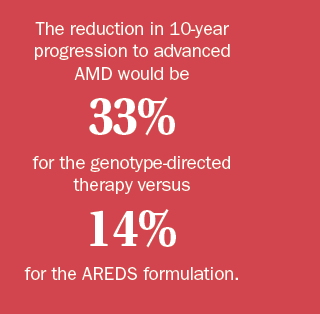Article
Nutritional therapy may fuel outcomes for moderate AMD
An analysis of patient data and DNA from the Age-Related Eye Disease Study (AREDS) indicates that two genetic polymorphisms predict a differential response to antioxidants and zinc, the components of the AREDS formulation.
Take-home:
An analysis of patient data and DNA from the Age-Related Eye Disease Study (AREDS) indicates that two genetic polymorphisms predict a differential response to antioxidants and zinc, the components of the AREDS formulation.

Dr. Awh
By Nancy Groves; Reviewed by Carl C. Awh, MD
Nashville, TN-Genetic testing may play a role in targeting nutritional supplementation in patients with age-related macular degeneration (AMD).
Investigators found that genetic polymorphisms could explain widely differing responses to treatment with zinc and antioxidants, suggesting that genotype-directed nutritional therapy could result in improved outcomes for patients with moderate AMD.
Genotype-directed nutritional therapy could more than double the reduction in AMD progression compared with treatment of all patients with moderate AMD with the supplementation formula used in the Age-Related Eye Disease Study (AREDS), which consists of high levels of zinc and antioxidants, said Carl C. Awh, MD, an ophthalmologist in private practice in Nashville, TN.
“The benefit of AREDS supplements for the average patient with moderate AMD is undeniable,” Dr. Awh said. “But we understand that this average benefit is driven by different individual responses, and we understand that these responses can be explained by differing genetic risk.”
In a study analyzing AREDS data and DNA, Dr. Awh and his colleagues found that patients with high-risk complement factor H (CFH) genotypes may benefit more from antioxidants alone than from the complete AREDS formulation, due to a deleterious interaction between CFH and zinc.
Similarly, they found that some patients with high-risk age-related maculopathy sensitivity 2 (ARMS2) genotype may benefit more from a zinc supplement than from the complete AREDS formulation.
Moreover, these findings are consistent with prior research on the roles of CFH and ARMS2. CFH binds with zinc, which can neutralize its ability to inhibit component C3b, thus increasing inflammation associated with AMD, and ARMS2 localizes to mitochondria, potentially affecting the interaction of antioxidants and free radicals.
The results of their analysis were published in Ophthalmology in November 2013.1 Noting that these findings are controversial, Dr. Awh said that further study-such as genetic subgroup analysis of the different zinc doses and antioxidant combinations used in AREDS2-may add insights to these findings.
The original AREDS randomly assigned patients into four groups assigned to take placebo, antioxidants, zinc, or antioxidants plus zinc. The Awh et al. analysis included 995 white AREDS patients with moderate AMD in at least one eye. The two-stage stratified statistical analysis was based on assigned AREDS treatment category. The placebo group had 235 patients; antioxidants, 256; zinc, 232; and antioxidants plus zinc, 272.
Risk factors
In a forward stepwise Cox regression analysis to identify which genetic or non-genetic risk factors were significantly associated with progression within each treatment group, only two of 15 factors were statistically significant: CFH and ARMS2 in the placebo group; ARMS2 in the antioxidant group; CFH in the zinc group; and CFH and ARMS2 in the antioxidants plus zinc arm.
Next, investigators performed separate Cox proportional hazards regression analyses limited to each treatment group and the significant risk alleles. The results showed the additive impact of CFH and ARMS2 risk alleles on response to treatment.
The risk ratio for patients treated with antioxidants alone was 2.58 with one ARMS2 allele (95% CI 1.63-4.10, p = 5.749E-05) and 3.96 if two alleles were present (95% CI 2.24-7.01, p = 2.219E-06).
In patients treated with zinc only, the presence of one CFH risk allele was associated with a risk ratio of 2.18 (95% CI 1.03-4.63, p = 4.161E-02), increasing to 4.46 with two CFH alleles (95% CI 2.12-9.35, p = 7.722E-05).
For patients treated with both zinc and antioxidants, the presence of two CFH risk alleles resulted in a risk ratio of 1.83 (95% CI, 1.15-2.91, p = 1.026E-02), and two ARMS2 risk alleles had a risk ratio of 1.89 (95% CI, 1.30-2.74, p = 8.540E-04).
“We are able to use these risk ratios to calculate progression in each treatment group,” Dr. Awh said. “We see that for patients with ARMS2 risk, we project that they are better treated with zinc without antioxidants, and that for patients with CFH risk alleles, they may fare better treated with high-dose antioxidants without high-dose zinc.

“If we look at our projected progression rates and the relative frequency of these genotype groups, we predict that the optimal treatment for 49% of study patients is something other than the AREDS formulation,” he said. “Based on this, if all study patients were treated with genotype-directed therapy, the reduction in 10-year progression to advanced AMD would be 33% for the genotype-directed therapy versus 14% for the AREDS formulation.”
Genotype-directed therapy could more than double the reduction in AMD progression compared with treatment of all patients with the AREDS formulation, Dr. Awh noted.
These findings have generated considerable discussion, Dr. Awh said, and addressed several issues. He agreed that the results need to be independently validated and stated that he and his co-authors have actively sought independent validation. As proof of this, they chose to publish their findings in the peer-reviewed literature before they were presented in any public forum. To date, no one has identified any errors in their peer-reviewed statistical analysis.
Dr. Awh also commented on an alternate statistical analysis of 1,425 patients presented by Dr. Emily Chew of the National Eye Institute, saying it was underpowered.
“Unlike our two-step, stratified analysis, they combined all four treatment groups and eight genotype combinations into a single regression analysis, reporting only a single p value,” he said. “Although this is a valid technique, this method requires more than 20,000 patients to have the power to detect the interaction we identified. As evidence of this, it fails to validate a peer-reviewed citation from their own abstract, an important paper by Dr. Klein.2 The p value differences were 25-fold.”
Subgroup analysis
Dr. Awh demonstrated that the statistical design of Dr. Chew’s analysis rendered it unable to replicate or invalidate his findings. To illustrate this, he presented a subgroup analysis with a similar design to Dr. Chew’s analysis, dividing AREDS study patients into nine separate genotype groups. Dr. Awh demonstrated that this method was statistically underpowered even to demonstrate that AREDS supplements were better than placebo.
Dr. Awh continued, “Does this mean that the AREDS formulation doesn’t work? Of course not. It just means that this is a poorly designed analysis to answer that question. To prove or disprove something is challenging. To simply not prove something is easy.”
He acknowledged that his study is a subgroup analysis and that some think the published treatment recommendations are not justified by the data. He explained that AREDS did not collect DNA from every patient and that he and his co-investigators used all available DNA from the AREDS DNA repository. DNA was available for almost 1,000 patients, and the analysis was based on this DNA and data obtained from the publicly available AREDS dataset. The widely referenced AREDS recommendations were also based on a subgroup analysis, he noted.
Dr. Awh concluded by acknowledging the benefit of AREDS supplements but emphasized that “we now understand that the overall benefit of AREDS supplements for patients with moderate AMD is the product of greatly differing individual responses and that these differences can largely be explained by measurable differences in genetic risk.”
References
1. Awh CC, Lane AM, Hawken S, Zanke B, Kim IK. CFH and ARMS2 Genetic polymorphisms predict response to antioxidants and zinc in patients with age-related macular degeneration. Ophthalmology. 2013;120:2317-2323.
2. Klein ML, Francis PJ, Rosner B, Reynolds R, Hamon SC, Schultz DW, Ott J, Seddon JM. CFH and LOC387715/ARMS2 genotypes and treatment with antioxidants and zinc for age-related macular degeneration. Ophthalmology. 2008;115:1019-1025.
Carl C. Awh, MD
P: 615/983-6000
Dr. Awh is a consultant to and an equity owner in ArcticDx.
Subscribe to Ophthalmology Times to receive the latest clinical news and updates for ophthalmologists.
Newsletter
Don’t miss out—get Ophthalmology Times updates on the latest clinical advancements and expert interviews, straight to your inbox.




